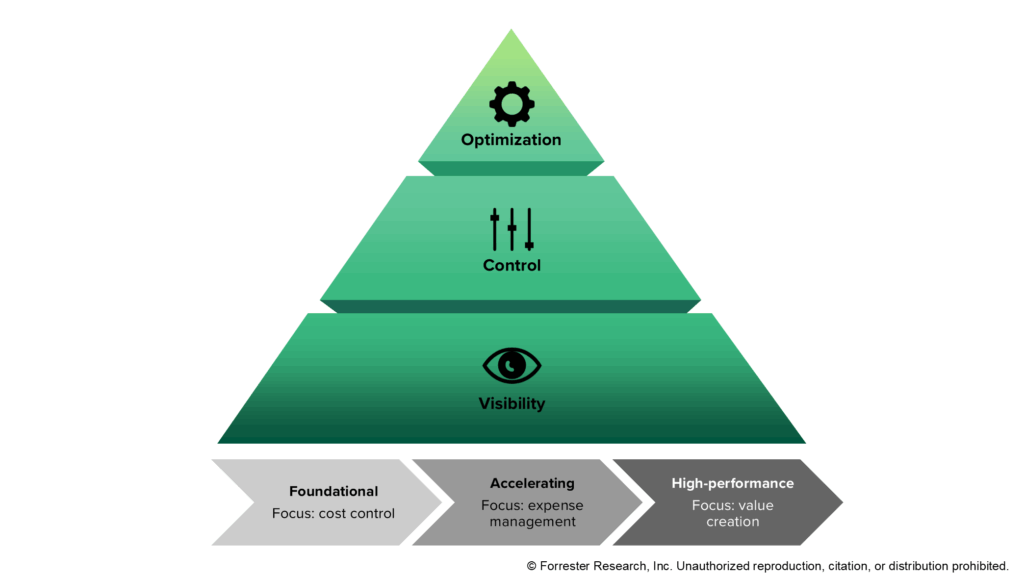Introducing Forrester’s IT Spend Management Framework
The current economic climate presents a significant challenge for CIOs. Tariffs and macroeconomic uncertainty are likely to temper IT spending growth in 2025 and 2026, and inflation continues to erode purchasing power, complicating CIOs’ efforts to secure meaningful budget increases. Yet amid these fiscal headwinds, artificial intelligence remains a paramount priority. In fact, Forrester’s Budget Planning Survey, 2025, indicates a strong commitment, with 78% and 74% of technology leaders planning to increase their budgets in generative AI and predictive AI, respectively.
To strategically fund these initiatives, your organization must embrace a disciplined approach to managing your IT spend. Forrester’s new IT spend management framework is built on three indispensable capabilities: visibility, control, and optimization. Mastering these elements will empower you and your team to align expenditures with strategic imperatives, unlock significant cost savings, and ultimately fuel the innovation necessary to thrive.
The Three Core Capabilities Of IT Spend Management
A robust IT spend management practice is built on these three capabilities:
- Visibility serves as the bedrock of effective IT spend management. It begins with a clear, comprehensive understanding of the entire IT financial landscape. Visibility goes beyond basic tracking. It involves delivering actionable insights into where resources are allocated, why, and how that allocation aligns with strategic business objectives. Achieving this requires a combination of analytical tools, automated data aggregation, and robust cross-functional collaboration. Without this clarity, decision-making remains reactive and crucial opportunities for optimization might be missed.
- Control institutes guardrails for financial discipline. Control is about establishing the necessary guardrails to ensure that IT spending is intentional, compliant, and strategically aligned. This involves implementing formalized governance structures, automating approval workflows, and embedding financial policies directly into development pipelines. Far from stifling innovation, effective control provides a stable framework for disciplined resource allocation. This empowers teams to act decisively within strategic boundaries and ensure operational efficiency.
- Optimization transforms cost savings into strategic value. Optimization involves systematically identifying and eliminating waste, automating workload management for peak efficiency, and leveraging cost insights to inform strategic prioritization. But high-performing IT organizations don’t just bank these savings; they strategically reinvest them into high-priority initiatives such as AI. They turn cost efficiency into a powerful engine for growth and competitive differentiation.

Navigate The Path To High-Performance IT Spend Management
Achieving mastery in IT spend management is an iterative journey. Progress across visibility, control, and optimization is often spurred by specific triggers: unexpected budget pressures, new compliance mandates, or the strategic imperative to fund initiatives such as AI.
To achieve substantial progress in IT spend management maturity, CIOs should guide their teams to tackle one capability at a time rather than all at once. Identify your most critical gap first; for instance, if runaway cloud costs are plaguing the budget, initial efforts should center on visibility and transparency. Create a centralized dashboard that encompasses all cloud spend in a single chart, then gather cross-functional stakeholders to communicate cost management initiatives transparently. With a reliable view of spending established, you can then confidently implement effective control measures to strengthen your overall financial governance.
Remember, these three pillars are interdependent: Heightened visibility facilitates precise control, and robust controls in turn lay the groundwork for effective, targeted optimization. Over time, these synergies cultivate a virtuous cycle of continuous improvement, enabling organizations to adapt even amid a challenging economic climate and the need to manage technical debt.
